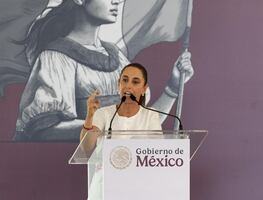Más Información

Osiel Cárdenas, exlíder del Cártel del Golfo, recibe auto de formal prisión; enfrentará juicio por homicidio

Jóvenes mexicanos pasan más de 2 mil horas al año en el teléfono; OCDE alerta sobre su impacto en la salud mental

Sergio Gutiérrez Luna destaca aprobación de 25 reformas en la 66 Legislatura; "Un logro histórico para la 4T", señala

Secretario de Agricultura reafirma defensa del maíz blanco; "Seguiremos apoyando la producción nacional no transgénica", afirma

¿Maíz transgénero? Rubén Rocha corrige desliz durante discurso en Sinaloa; destaca importancia del maíz blanco

Sheinbaum asegura apoyo total a Sinaloa para enfrentar violencia; "Nunca los vamos a dejar solos, aquí está la presidenta"
Given the lack of mechanisms or public policies which can protect the intangible cultural heritage of indigenous peoples, legislators, lawyers, anthropologists and experts on the subject appeared before the Senate of the Republic yesterday to talk about the this issue and propose solutions to prevents plagiarism and the exploitation of the creations of native peoples.
At the forum “Intangible Cultural Heritage. Collective Rights,” experts like the anthropologist Marta Turok and Marina Anguiano talked about the practices of national and foreign designers to take the iconography of the native Mexican artisans.
“When commercial corporations take tangible elements of the native cultures, they lose the essence of the intangible; they fracture it and strip away its meaning. They turn indigenous culture into a marketable product to earn a profit - this is why we need laws to protect it,” said Anguiano, researcher of the National Institute of History and Anthropology ( INAH ).
Turok, meanwhile, stressed the creation of a legislation on this matter requires the agreement between companies and designers, and the own indigenous peoples, because, according to her, one of the problems is the lack of organization with the indigenous communities. “In some cases, only a few benefit despite this being a collective heritage ...We need to listen to the peoples, to the companies; otherwise our law will only look good on paper but to reach agreements we need to listen to all the parties involved.”
Anthropologists Bolfy Cottom and Aída Castilleja agreed that registering the artisnanal and textile designs can work as a protection instrument. Cottom said that instead of creating a new law, the existing ones should be reviewed, such as the General Law on Culture and Cultural Rights, and enforce them.
There were other attendants to the meeting, such as singer Susana Harp and the director of the Popular Cultures of the Ministry of Culture, Jacinto Chacha, senators María del Rocío Pineda, Gerardo Sánchez, and Jorge Toledo, who supported the idea of finding a legal instrument to protect the cultural richness of Mexico.
am




